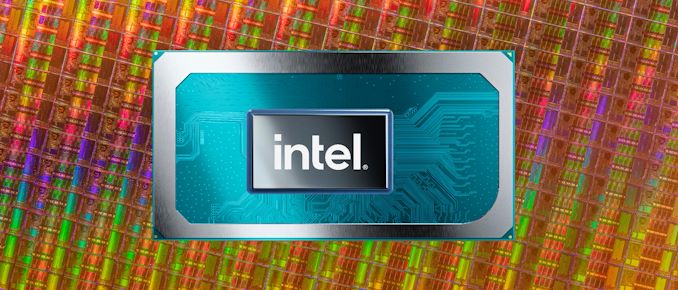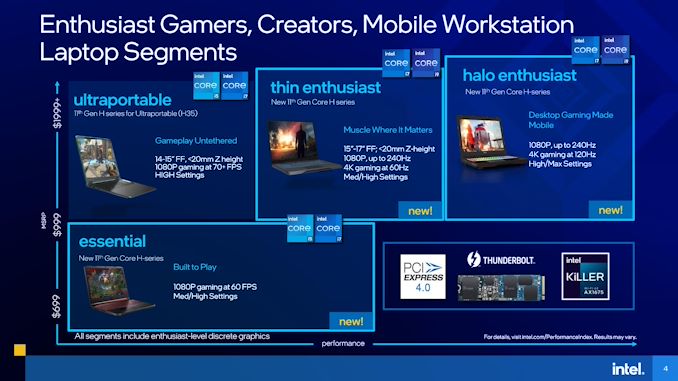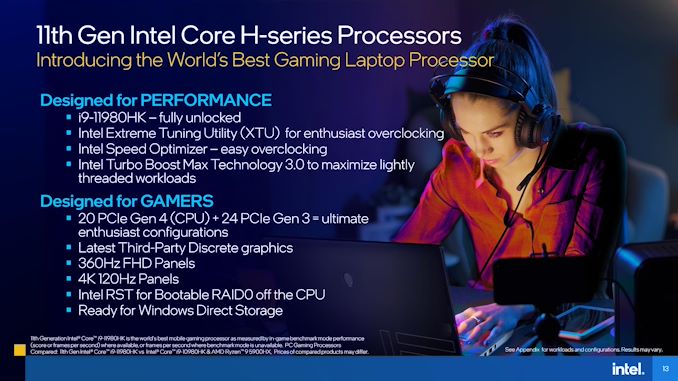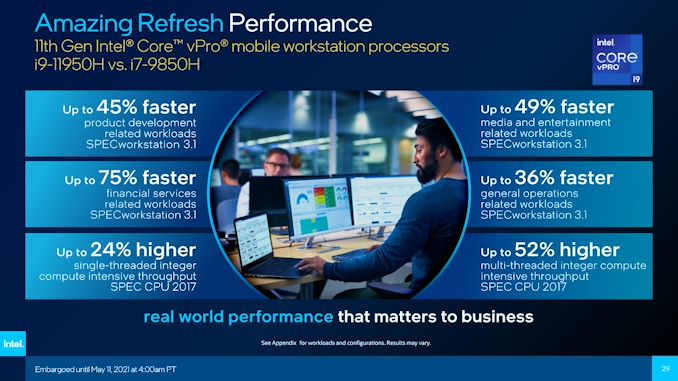Intel Launches 11th Generation Core Tiger Lake-H: Eight Core 10nm Mobile Processors
by Dr. Ian Cutress on May 11, 2021 7:00 AM EST- Posted in
- CPUs
- Intel
- Overclocking
- 10nm
- Xe-LP
- Willow Cove
- Tiger Lake-H
- i9-11980HK
- TGL-H

Ever since the launch of the first series of Intel Core 11th Generation Tiger Lake processors aimed at the ‘U-series’ 15 W market, Intel has teased us that there was another design being produced in the wings. While the Tiger Lake-U was built for portability, battery life, and integrated graphics, the Tiger Lake-H series would double the cores, and be the partner for premium mobile gaming as well as on-the-go muscle. Today is the launch of this new platform, and Intel is promoting over 1 million Tiger Lake-H processors shipped to partners and 80 devices coming to market.
A Quick Recap: Intel Mobile Segmentation
For those who are unfamiliar with Intel’s mobile strategy, it falls into several categories, usually designated by the letter. Over time Intel has been moving around within these categories to define different design points for end-user products, but they have by and large stayed the same. As follows:
| AnandTech | Main TDP |
TDP Range |
Info |
| Y-Series | - | 4-10 W | Novel small form factor Sustained battery life |
| U-Series | 15 W | 12-28 W | 10-14 inch ultraportable Usually reliant on integrated graphics. Some with discrete GPU for portable gaming |
| H35-Series | 35 W | - | New for Tiger Lake. Not actually H, just a high-powered U. |
| H-Series | 45 W | 35-65+ W | 14-17 inch high-performance More cores, discrete graphics 'portable' high-performance gaming Workstation/desktop replacements |
For the new eight-core Tiger Lake-H processors, Intel highlights three key markets:
- Essential: Paired with mid-range GPU, 1080p Gaming at 60 FPS, Medium/High Settings
- Thin Enthusiast: 15+ inch, sub-20 mm, Gaming at 1080p240 or 4K60 at Medium/High
- Halo Enthusiast: 15+ inch, Gaming at 1080p240 or 4K120 at High/Max Settings
The new H-series processors will also have corresponding vPro versions for commercial deployment, and Intel is saying that out of the 80+ designs currently using the new 11th Gen Core Tiger Lake-H, about 15 of them will be vPro focused.
Tiger Lake-H (TGL-H) Processors on Offer
While users might be accustomed to seeing a wide array of Intel processors each differing by the smallest of margins, today’s launch has only five models for consumers, and another five for commercial systems. At the heart are Intel's latest Willow Cove processor cores, with 1.25 MB of exclusive L2 cache, and up to 3 MB of shared L3 cache per core, along with Intel's latest Xe-LP graphics. These all start at six cores and twelve threads, and offer up to 5.0 GHz single-core turbo for the most expensive models.
| Intel Tiger Lake-H Consumer | |||||||||
| AnandTech | Cores Threads |
35W Base |
45W Base |
2C Turbo |
4C Turbo |
nT Turbo |
L3 Cache |
Xe GPU |
Xe MHz |
| i9-11980HK | 8C/16T | - | 2.6 | 5.0* | 4.9 | 4.5 | 24 MB | 32 | 1450 |
| i9-11900H | 8C/16T | 2.1 | 2.5 | 4.9* | 4.8 | 4.4 | 24 MB | 32 | 1450 |
| i7-11800H | 8C/16T | 1.9 | 2.3 | 4.6 | 4.5 | 4.2 | 24 MB | 32 | 1450 |
| i5-11400H | 6C/12T | 2.2 | 2.7 | 4.5 | 4.3 | 4.1 | 12 MB | 32 | 1450 |
| i5-11260H | 6C/12T | 2.1 | 2.6 | 4.4 | 4.2 | 4.0 | 12 MB | 32 | 1400 |
| *Turbo Boost Max 3.0 | |||||||||
The most premium model is the Core i9-11980HK, which looks more akin to a desktop processor! Intel has the eight-core part rated at 2.6 GHz for 45 W, but also lists a base frequency of 3.3 GHz for 65 W. What makes this processor special compared to the others is that it can also be overclocked further than 65 W in systems that allow it. Overclocking on laptops is usually a bit hit and miss, but this is actually the first ever overclockable 10nm processor from Intel. That accolade typically goes to the desktop platform, but this is the first time in recent memory I’ve seen Intel launch an overclockable mobile processor first.
The Core i9-11980HK gets the best of Intel’s design here: 4.5 GHz all-core turbo, 4.9 GHz traditional turbo, and 5.0 GHz with Turbo Boost Max 3.0 on up to two favored cores. The integrated graphics is the base Xe-LP architecture with 32 execution units running at 1450 MHz peak. All processors listed have 32 execution units, with a 350 MHz base and variable peak frequencies.
The other processors here follow Intel’s traditional non-overclocked schema, whereby 45 W is the standard rating and 35 W is the power-down option. The Core i9-11900H for example has Turbo Boost Max 3.0 on two cores up to 4.9 GHz, like the other Core i9, and TBM 3.0 is the main difference down to Core i7 which is also eight-core and sixteen thread.
Compared to Intel’s best TGL-U processors, the Core i7-11375H SE (35W) and the Core i7-1185G7 (28W) are quad-core processors but have much better-integrated graphics.
| Intel Tiger Lake-H Commercial | |||||||||
| AnandTech | Cores Threads |
35W Base |
45W Base |
2C Turbo |
4C Turbo |
nT Turbo |
L3 Cache |
Xe GPU |
Xe MHz |
| W-11955M | 8C/16T | 2.1 | 2.6 | 5.0* | 4.9 | 4.5 | 24 MB | 32 | 1450 |
| i9-11950H | 8C/16T | 2.1 | 2.6 | 5.0* | 4.9 | 4.5 | 24 MB | 32 | 1450 |
| i7-11850H | 8C/16T | 2.1 | 2.5 | 4.8 | 4.8 | 4.3 | 24 MB | 32 | 1450 |
| W-11855M | 6C/12T | 2.6 | 3.2 | 4.8* | 4.7 | 4.4 | 18 MB | 32 | 1450 |
| i5-11500H | 6C/12T | 2.4 | 2.9 | 4.6 | 4.4 | 4.2 | 12 MB | 32 | 1450 |
| *Turbo Boost Max 3.0 | |||||||||
On the commercial front, Intel is mixing up the names between Core and new Xeon W-11000M series processors. There is no overclockable processor here, but the specifications are somewhat identical with 45 W as standard and 35 W optional operating modes. These processors differ because they feature Intel’s vPro, a commercial system allowing for company administration control, Intel Hardware Shield, Total Memory Encryption, and a number of other features to assist deployment across the infrastructure of a business-focused environment. These processors also have ECC memory support, and will defend against cryptocoin mining through detection when used with Microsoft Defender Endpoint.
It is worth noting here that the W-11855M is the odd processor out. It has six cores, but comes with Turbo Boost Max 3.0. It also has 18 MB of L3 cache, the full 3 MB per core, whereas the other 6C processors only have 2 MB per core. I suspect that the W branding is often associated with having as much cores and cache as possible, as in previous generations this has usually been the case.
Tiger Lake-H Silicon and Platform
Compared to the previous Tiger Lake-U silicon, we now get a full eight Willow Cove cores on die, up from four, as well as 20 lanes of PCIe 4.0 for discrete graphics and storage. The overall silicon measures in at around 190 square millimeters, uses Intel’s latest Xe-LP graphics and media engines enabling AV1 decode support, and also has built-in Thunderbolt 4 controllers.
All Tiger Lake-H processors will support DDR4-3200, however it is worth noting that these processors do not support LPDDR4. We expect this to be a more holistic choice that these platforms are not battery life focused, and TGL-H customers prefer having DDR4 as it supports double the capacity (as well as usually being user-replaceable, depending on the design).
The 20 lanes of PCIe 4.0 can be split in three different ways:
- x16 for graphics, x4 for storage
- x8/x8 for graphics, x4 for storage
- x8 for graphics, x4/x4/x4 for storage
In the latter configuration, with up to three PCIe 4.0 x4 storage devices, Intel also supports bootable RAID 0. This is somewhat an obscure configuration, however we have seen MSI desktop-replacement systems come with multi-drive RAID 0 in the past.
The chipset for TGL-H is separate to the CPU, and so there will be a number of mobile chipsets on offer, however Intel has updated the most powerful chipset to a DMI x8 link, offering double the bandwidth back from the chipset to the processor. From the chipset there are another 24 PCIe 3.0 lanes as well as MIPI support for Intel’s Image Processing Unit 6.
Thunderbolt 4 is natively supported, although USB4 is not listed. There is USB 3 support, however Intel fails to list if this is USB 3.2 Gen 1 or Gen 2. For networking, systems can either use a discrete Ethernet controller, or use the chipset integrated Killer AX1675 Wi-Fi 6E solution (if the OEM purchases the corresponding Intel CNVi RF interface). For those of you wondering why Intel is pairing with Killer for the networking here, it’s because Intel acquired the company behind Killer, Rivet Networks, last year for an undisclosed sum.
Intel promotes that TGL-H is ready for Windows Direct Storage, and with appropriate third-party discrete graphics can support the latest 360 Hz 1080p panels or the latest 4K 120 Hz panels. Resizeable BAR is also supported.
Performance
As always with these launches, Intel provides first-party benchmark numbers. We’re loathed to mention any of them, simply because we prefer to validate the claims ourselves.
One thing we can already confirm however is the raw processor improvements: as we saw in previous Tiger Lake systems, Intel offers ‘up to 19%’ better performance per clock over the previous generation. In this comparison, Intel is comparing Tiger Lake-H to Comet Lake-H, which is a derivative of Intel’s 6th Generation architecture. Gains in that market are very much an average of 19%.
But it might be worth noting that comparing against Comet Lake-H is not comparing against Intel’s architectures in chronological order. If we compare Tiger Lake to Intel’s previous 10nm product, Ice Lake, the design of the core means that while some benchmarks did improve, others regressed, leading to overall parity in performance compared to Ice Lake. The only reason Intel isn’t comparing against Ice Lake in its product comparisons is because Ice Lake at 15 W against Tiger Lake at 45 W is too big a power disparity, and mainly a frequency differential will drive Tiger Lake higher.
Intel’s benchmarks against AMD are a bit trickier, given it is hard to compare laptop-vs-laptop given that different designs will have different optimization points. However in an iso-comparison with an RTX 3080 (giving AMD the benefit of the doubt on TDP and a bigger chassis for cooling), and with all settings and cooling features and fans set to maximum, Intel is claiming 20% better average gaming performance with a Core i9-11980HK (65W?) against a Ryzen 9 5900HX (45W?), or iso-performance comparing a Core i5-11400H (45 W?) and a Ryzen 9 5900HS (35 W?). There are a lot of question marks there because Intel’s appendix of test setups mentions only ‘maximum performance setting’ for each system, and that in-itself is variable based on the OEM.
The one performance slide that’s good to put up is probably this one, where Intel compares an example 3-year refresh performance improvement for a commercial high-end system. Some of these workloads can leverage the AVX-512 units, the Xe-LP graphics, or other accelerators that Intel now includes in Tiger Lake-H.
Timescale and Availability
Intel’s launch today states that there are 80+ enthusiast designs with Tiger Lake-H, however exactly how many will be available today is an unknown – we suspect that these designs will come out over the rest of the year. Intel also lists 1 million TGL-H processors shipped to its OEM partners by launch. Normally Intel discloses a few key partner designs with us alongside the launch, but this time that did not happen. NVIDIA also has a corresponding launch today for products designed to fit well with these sorts of systems, so perhaps there is some sort of tie-in. The systems are being launched worldwide, but the launch event is officially in China, hence the early morning US announcement today.
We’re expecting to get hold of a couple of Tiger Lake-H systems for testing over the next month or so – a ‘high-end’ example as well as a halo design.














164 Comments
View All Comments
Spunjji - Thursday, May 13, 2021 - link
@vladx - more projection. You're one of the least-informative and most reliably biased posters in these comments.Spunjji - Thursday, May 13, 2021 - link
Did I say there were "no issues"? No, I didn't. I objected to your compulsive ranting. Still do.Get a better hobby, go outside, touch grass - whatever you need to do. 🤷♂️
mode_13h - Tuesday, May 11, 2021 - link
> What is ADL going to be ? A miracle out of a hat ? Nope. It will be a mess.At worst, it'll be Tiger Lake-H on a bigger power budget. And that's if you don't even touch the little cores.
To be honest, I don't really care about the little cores, for desktop use. I think they're mostly an attempt to add more multithreaded performance on the cheap, because the little cores have more PPA than the big cores. Most desktop users don't run 24-thread workloads, anyhow. Maybe it's just Intel's way of trying to gin up some better multithreaded benchmark numbers.
As for thread-scheduling, Big.LITTLE architectures have been with us for about a decade. I think there's probably a wealth of experience with the scheduling challenges they pose, although I'm sure we'll see corner cases where it causes some issue. And most of those will probably be smoothed over, after a few OS patches.
Silver5urfer - Wednesday, May 12, 2021 - link
Same I also do not care for the small x86 cores, but Intel is only doing it to fab one single silicon for both Desktops and Laptops to save cash, they do this all the time as everyone knows it, and bottom barrel silicon ends up in Laptops which is why all the laptops have high stock voltage out of the box.Thread scheduling problems will occur on Windows no matter what, the OS is not built like that but with the bs thin and light market addiction for both OEMs / Intel / AMD / Apple / Users. M$ will make an update without a doubt as they will also benefit with this approach for their Surface BGA locked down HW. Windows x86 / Win32 never used it so it will have first wave of issues. Just like how Ryzen had with Threadripper CPUs. Smoothness with Windows 10 as a Service is questionable at it's best.
ADL won't be a good product. People should wait for Zen 4 / Raptor Lake if they want to get DDR5 and Gen 5.
Spunjji - Thursday, May 13, 2021 - link
"bottom barrel silicon ends up in Laptops which is why all the laptops have high stock voltage out of the box"It's basically the other way around. Bins that can run on low voltage go to laptops, bins that need higher voltage and have a higher clock headroom go to desktop. This is basic stuff.
Silver5urfer - Thursday, May 13, 2021 - link
What a complete utter dumb nut. Unfit for AT as I mention always. Better silicon is called golden because it needs lower voltage than rest to hit high clockspeed be it overclock or boost clock, while low bin needs more voltage than that golden sample.Intel does this often with CFL 8086K, 9900KS, CML Limited edition, X299 HEDT 9990XE. While this dumb person thinks its high voltage have high clock only hahaha LOL.
Next the laptop users scour interwebs on how to tune their processors which is seen in so many forums esp Notebookreview and there's a specific software to do that instead of garbage XTU. PLUS people always try to UV them because its high voltage out of box this has been the case since Haswell, Intel is putting better bins in laptops and using trash bin on desktop as per your retarded logic hahaha this is epic. Even worse than AMD fanboy logic.
ZERO knowledge and has useless personal projecting issues on others. Now I'm clear its a complete waste of time to pay attention on subject with you solid room temp IQ. I kinda expected this from a wokie before only.
Spunjji - Thursday, May 13, 2021 - link
@Silver5urfer - "...has useless personal projecting issues on others."'Nuff said.
"Better silicon is called golden because it needs lower voltage than rest to hit high clockspeed"
This is a huge oversimplification. Low-leakage silicon often has a lower voltage headroom than high-leakage silicon. It's not just "good silicon" and "bad silicon", different bins have different characteristics, and the batches with the best characteristics for a given platform get used for them.
I know full well about Throttlestop, I've used it. My Skylake notebook undervolted like a peach. The thing is, talking about *individual users* undervolting their notebook CPUs has *nothing* to do with how Intel bin entire product lines.
But sure, keep casually tossing slurs at me, that'll convince everyone!
Qasar - Thursday, May 13, 2021 - link
" But sure, keep casually tossing slurs at me, that'll convince everyone! "i think thats all he has left. well, other then ranting.
ottonis - Wednesday, May 12, 2021 - link
Nobody actually expects Alder Lake to dominate performance wise. Alder Lake is just a first step into the field of hybrid core packages with the aim to further improve on on overall work efficiency - similar to ARMs big.LITTLE concept and the same concept that Apples M1 architecture is pursuing.That being said, Alder Lake is just tipping the toes into these new waters, as it will be inevitable for Intel (as well as for AMD) to further optimize the per-core efficiency of their *performance*- cores if they want to compete with Apple.
One important aspect is of course the process node, and Apple has an edge over everybody else in the x86 market, as the M1 is built in a 5nm process.
mode_13h - Thursday, May 13, 2021 - link
> Nobody actually expects Alder Lake to dominate performance wise.I think Intel is putting the little cores in there because they think that will make it more competitive, or at least benchmark better.
Intel makes internal research chips that never see the light of day. So, this isn't just them running a sort of experiment.
I think it *is* something they probably wouldn't do, without competitive pressure from ARM and AMD. It's a little more adventuresome and risky than their typical MO.
> Apple has an edge over everybody else in the x86 market, as the M1 is built in a 5nm process.
Not just Apple, but also Qualcomm and others.